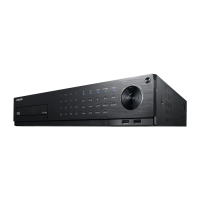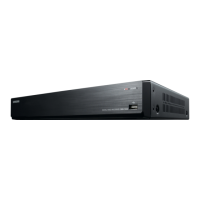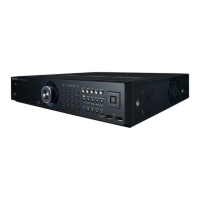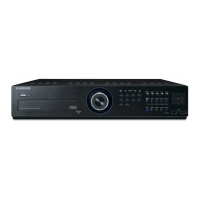
Do you have a question about the Samsung SRD-1680D and is the answer not in the manual?
| Video Input | 16 Channels |
|---|---|
| Compression Format | H.264 |
| Power Supply | 12V DC |
| Audio Inputs | 16 Channels |
| Audio Outputs | 1 Channel |
| Hard Drive Bays | 1 |
| RS-485 | Yes |
| Operating System | Embedded Linux |
| Video Output | BNC x 1, VGA x 1, HDMI x 1 |
| Network Interface | Ethernet |
| Recording Rate | 120 fps (NTSC), 100 fps (PAL) |
| USB | 2 USB 2.0 |
Read these operating instructions carefully before using the unit. Follow all the safety instructions.
Details the functions of each button on the remote control for device operation.
Provides operational information necessary for using the product and contains a description about each component part.
Identifies and describes the functions of the front panel components and controls.
Identifies and describes the functions of the rear panel ports and connectors.
Provides warnings and cautions regarding battery, power connection, and system shutdown procedures.
Highlights key features such as H.264 compression, network connectivity, and various recording modes.
Offers advice on setting passwords for the DVR and wireless network to prevent threats.
Recommends environmental conditions for installation to prevent product breakdown and ensure longevity.
Details the process of installing the bracket-rack, including screw fastening and foot separation.
Provides essential steps and cautions for installing the Hard Disk Drive (HDD) safely.
Highlights the importance of securing the HDD properly and checking compatibility before installation.
Provides a step-by-step guide for accessing the HDD bay by opening the unit's cover.
Describes network connection setup when using a broadband router.
Explains how to establish a network connection using an Ethernet cable.
Details network connection setup using PPPoE, requiring user ID and password.
Provides initial steps for starting the system, including power connection and boot-up.
Explains the procedure for safely shutting down the DVR system, requiring login.
Details how to log in to the DVR to access menus and features, requiring ID and password.
Illustrates various split screen layouts available for displaying live images from multiple channels.
Provides methods to switch between different screen modes via launcher or context menu.
Allows configuration of system properties, devices, and options for recording, event, backup, and network.
Enables setting recording options for events like sensor, motion, video loss, or tampering.
Guides on checking network environment before setting connection modes.
Enables setting user permissions for DVR functions and settings.
Details how to set and change the Administrator's ID and password.
Guides on connecting a device with software to update the DVR and the update process.
Allows setup of Camera, Storage Device, Remote Device, POS Device, and Monitor settings.
Guides on matching PTZ camera functions, ID, and protocols with the DVR for proper operation.
Allows checking storage devices, their free space, usage, and status.
Provides instructions on how to format a storage device connected to the DVR.
Allows setting alarm configurations for HDD defects, including output ports and duration.
Sets motion detection mode, sensitivity, alarm output, and duration.
Details PTZ operations like PAN, TILT, ZOOM, and setting presets for multiple views.
Enables setting Video, Audio, Channel Name, and Dwell Time for each camera.
Details how to check storage devices, including HDD and USB devices, and their status.
Guides on selecting and defining motion detection regions for each channel.
Allows checking backup devices and setting backup schedules by channel or time.
Guides on configuring Video, Audio, CH Name, SEQ-Dwell Time, Screen Setup, and Privacy Region.
Guides on backing up desired data to a connected device.
Configures the protocol and environment for network connectivity.
Guides on scheduling recordings for specific dates and times.
Introduces PTZ camera control capabilities, activated when a channel is selected.
Explains how to access PTZ controls via remote, launcher menu, or right-click.
Enables searching recorded data by time or search criteria like events.
Provides detailed steps for searching recorded data based on specific dates and times.
Allows searching for recorded events by channel and playing them.
Enables searching for backup data stored on connected backup devices.
Explains how to search for motion detection events within specific areas.
Describes how to play recorded data from HDD or backup, and manage playback controls.
Explains the Search Viewer interface and its components for finding recorded video.
Allows checking and changing settings for storage devices like HDD and external drives.
Allows setting motion detection mode, sensitivity, alarm output, and duration.
Enables setting the Disk End Mode for HDD full conditions.
Guides on accessing DVR network settings like connection mode and IP address.
Enables setting alarm output channels and durations for HDD errors.
Guides on setting the target motion detection area for each channel.
Allows setting the network connection route and related protocols.
Provides information on setting events like sensor detection, motion, and video loss.
Provides instructions for connecting to the DVR via web browser on Windows.
Details the components and functions of the Live Viewer interface on Windows.
Details the Live Viewer interface and its components on Mac, including menu and display pane.
Explains how to control PTZ camera functions like direction, speed, presets, and zoom.
Enables checking and configuring settings for connected devices like cameras and PTZ.
Guides on configuring camera settings such as video, privacy region, and PTZ.
Details how to configure PTZ camera settings, including ID and protocol.
Guides on setting a recording schedule for specific dates and times.
Provides detailed technical specifications for SRD-880D and SRD-1680D models.
Details network, smart phone, storage, security, interface, and monitor specifications.
Details audio, alarm, connections, electrical, environmental, mechanical, and language specifications.
Covers symptoms related to disk recognition, date/time resets, time bar display, and network configuration.
Addresses issues with recording functionality and poor image quality of recorded data.
Lists factory default settings for Date/Time/Language, Permission Management, and System Management.
Details factory default settings for Device (Remote, POS, Monitor) and Recording (Schedule, Quality, Option).
Lists factory default settings for Event (Detection, Schedule) and Network (Connection, DDNS, Mailing, SNMP).
Lists common system symptoms and provides corresponding countermeasures for resolution.











